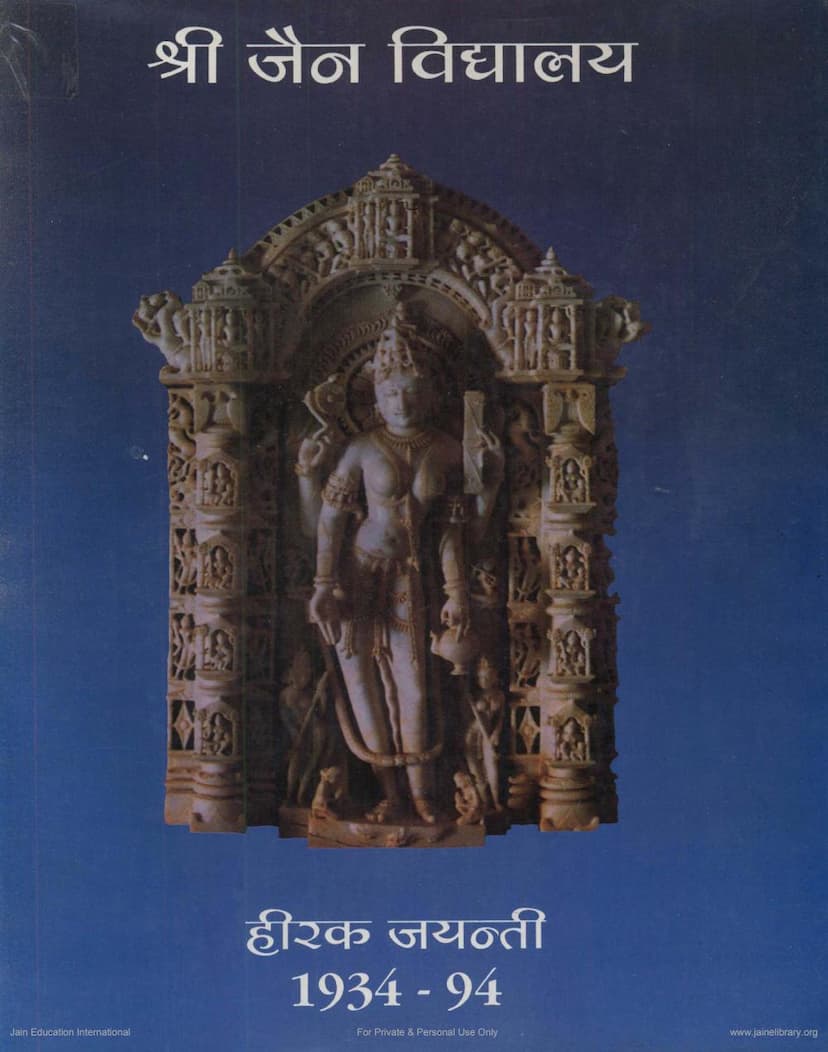Jain Vidyalay Hirak Jayanti Granth
Added to library: September 2, 2025

Summary
Here's a comprehensive summary of the Jain Vidyalaya Hirak Jayanti Granth, based on the provided text:
Book Title: Jain Vidyalay Hirak Jayanti Granth Author: Kameshwar Prasad (and Editorial Board) Publisher: Jain Vidyalaya Calcutta Occasion: Diamond Jubilee (1934-1994) of Shree Jain Vidyalaya, Calcutta.
Overall Theme: This "Hirak Jayanti Granth" (Diamond Jubilee Souvenir) is a commemorative publication celebrating 60 years of Shree Jain Vidyalaya, Calcutta, and its sister institution, Shree Jain Vidyalaya, Howrah. The souvenir reflects on the institution's journey, its contributions to education, and its philosophical underpinnings, emphasizing the Jain principles of right knowledge, right vision, and right conduct. It also highlights the broader societal role of education and the importance of moral and spiritual development alongside academic learning.
Key Content and Sections:
-
Genesis and Vision (Page 4):
- The Vidyalaya was established in 1934 by the Shwetambar Sthanakvasi Jain Sabha, a group motivated by the fervor of the Indian independence movement and a commitment to holistic education (knowledge, philosophy, and character).
- It started in a single rented room in Pancha Gali, symbolizing the humble beginnings of a seed that has grown into a banyan tree.
- The educational philosophy extends beyond mere livelihood training, aiming to develop responsible citizens who can contribute to society and the nation, even making personal sacrifices when needed.
-
Current Status and Achievements:
- The Vidyalaya currently educates approximately 2500 students, offering science and commerce streams.
- It holds a leading position in Bengal for its 100% examination pass rate, high-quality teaching, and strict discipline.
- The school is equipped with modern educational resources and has introduced computer education from Class 5.
-
Critique of Modern Education and Societal Challenges (Page 4-5):
- The publication expresses concern about the current education system being directionless and youth facing despair, unemployment, fear, and restlessness.
- It laments the prevalence of corruption, dishonesty, exploitation, and immorality in the world.
- A critical need for balancing scientific advancement with spirituality, self-control, and discipline is emphasized to prevent potential "total annihilation."
- Spirituality and character-building are presented as the beacon of hope in this darkness.
-
The Role of Educators and Stakeholders (Page 5):
- The success of the educational mission relies on the combined efforts of teachers, parents, and management.
- Teachers are revered as equivalent to Brahma, Vishnu, and Mahesh, carrying a significant responsibility for character development.
- Strong resolve and commitment are highlighted as keys to achieving the impossible.
-
The Souvenir's Purpose and Content (Page 5-6):
- The souvenir is published to commemorate the six-decade journey of the Vidyalaya.
- It includes articles from scholars, thinkers, and dignitaries, covering various subjects.
- The publication is structured into distinct sections: Vidyalaya Khand (School Section), Vidvat Khand (Scholars' Section), Adhyapak Khand (Teachers' Section), and Vidyarthi Khand (Students' Section).
- The cover features a 12th-century sculpture of Saraswati found in Palli village, Bikaner, Rajasthan, with Jain Tirthankaras depicted in the halo.
-
Key Contributors and Office Bearers (Page 6-8):
- The souvenir lists the Managing Committees of Shree Jain Vidyalaya, Calcutta, and Howrah, as well as the Shree Shwetambar Sthanakvasi Jain Sabha.
- It acknowledges the contributions of numerous past and present office bearers, presidents, secretaries, and principals who have guided the institutions.
- The table of contents provides a diverse range of articles, including reflections on the school's history, impressions, educational philosophy, societal issues like environmental pollution, historical events, literary analyses, and student contributions.
-
Specific Article Themes (from Table of Contents - Page 8-11):
- Vidyalaya Khand: Focuses on the school's history, development, achievements, and impressions from various individuals (e.g., "The institution was formed in a word," "The fundamental mantra of development and progress," "Shree Jain Vidyalaya: A Pride for the Community").
- Vidvat Khand: Features contributions from renowned scholars and spiritual leaders on diverse topics ranging from spiritual principles ("May the foundation of peaks of excellence be like this") to language, socio-economics, literature, environmental issues, and the teachings of Lord Mahavir and Jain philosophy. Notable articles include discussions on Hindi language, the role of socialism in national development, analysis of Kalidasa's depiction of separation, Jain Agam literature, environmental pollution, the spread of Jainism, and the significance of morality.
- Adhyapak Khand: Showcases articles by teachers on historical and educational topics, such as the history of Indian mathematics, analyses of literary figures like Agyeya, and the philosophical underpinnings of Jainism.
- Vidyarthi Khand: Contains creative writing and reflections from students on themes like social issues (e.g., dowry, brain drain, corruption), personal aspirations, and reflections on Indian culture and the importance of education.
-
Emphasis on Jain Values and Service:
- The text repeatedly stresses the importance of nishkam seva (selfless service) and sadhana (dedication) as the core principles of the institution's growth.
- The concept of Samyak Darshan (right perception), Samyak Gyan (right knowledge), and Samyak Charitra (right conduct) are presented as the guiding principles for students.
- The establishment of the Howrah branch and plans for a hospital underscore the Sabha's commitment to societal service.
In essence, the "Jain Vidyalay Hirak Jayanti Granth" is more than just a school souvenir; it's a testament to the enduring legacy of an educational institution deeply rooted in Jain philosophy and a strong sense of social responsibility. It celebrates achievement while acknowledging contemporary challenges and calls for continued dedication to the principles of education, service, and spiritual growth.